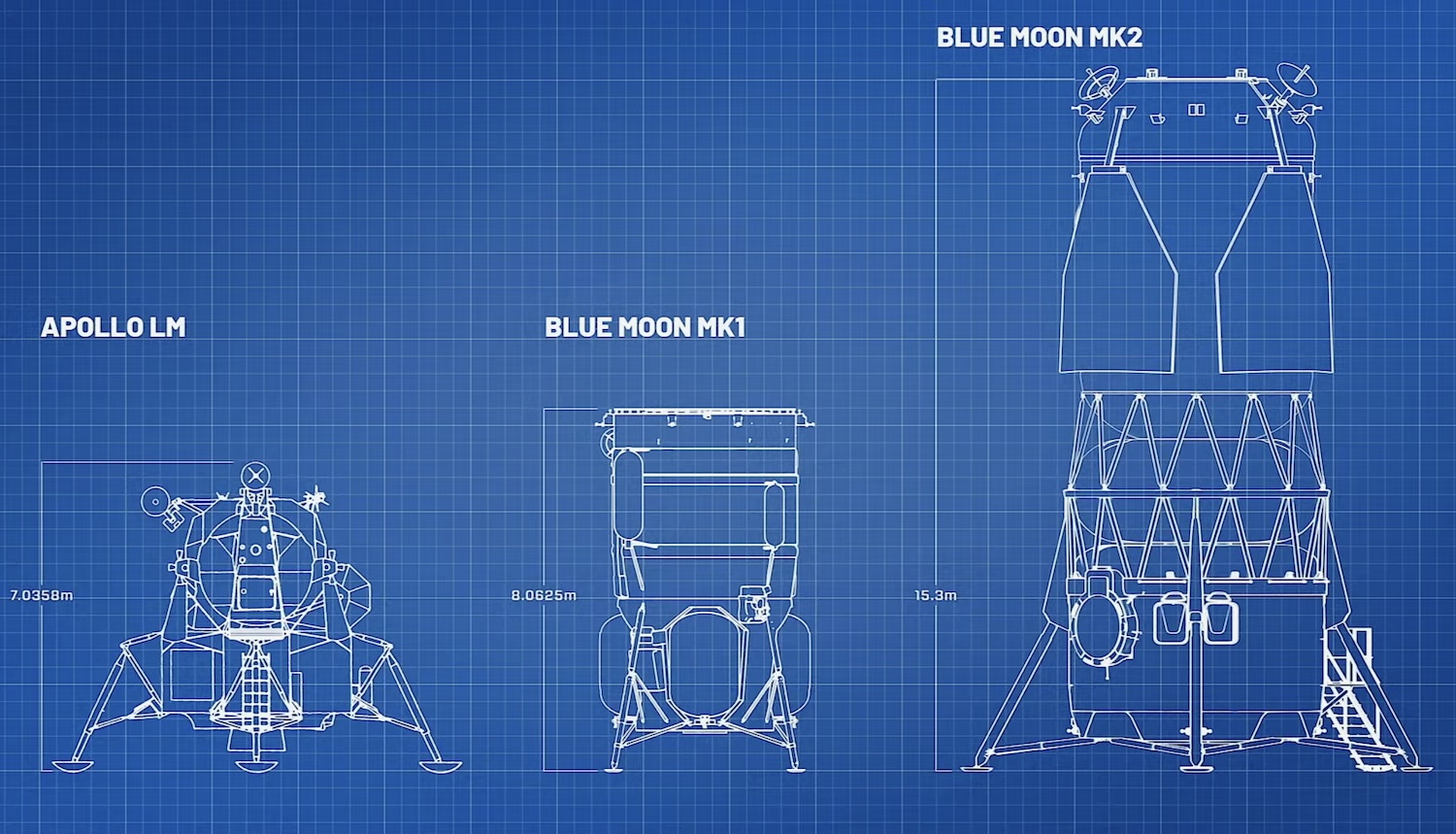"There's not yet a commercial reason only to go to the Moon with humans."
In this long exposure photograph, Blue Origin's New Glenn rocket pierces a cloud deck over Florida's Space Coast on its inaugural flight January 16. Credit: Blue Origin
Eighteen months after leaving his job as a vice president at Amazon to take over as Blue Origin's chief executive, Dave Limp has some thoughts on how commercial companies and government agencies like NASA should explore the Solar System together.
Limp had no background in the space industry before taking the helm of Jeff Bezos' space company in December 2023. He started his career as a computer scientist at Apple, took a stint at a venture capital firm, and joined Amazon in 2010, where he managed development of consumer devices like Alexa, Kindle, and the Fire TV.
"I had no thoughts of ever running a space company," Limp said Thursday at a space conference in Washington, DC. "I've done consumer electronics my whole life. Started at Apple and did a bunch of other things, and so when I decided to retire from Amazon, I was looking for something that I could give back a little bit, be a little bit more philanthropic in the sort of second half of my career. I didn't want to stop working, just wanted to do something different. And about that same time, Jeff was looking for a CEO."
While he's still a relative newcomer to the space business, Limp's views align with those of many policy wonks and industry leaders who have the ears of senior officials in the Trump administration, including Jared Isaacman, President Trump's nominee to become the next NASA administrator. Limp's long tenure at Amazon and his selection as Blue Origin's new CEO demonstrate that he also has the trust of Bezos, who was dissatisfied with his company's slow progress in spaceflight.
"I think Jeff convinced me, and he's very persuasive, that Blue didn't need another rocket scientist," Limp said. "We have thousands of the world's best rocket scientists. What we needed was a little bit more decisiveness, a little bit more ability to think about: How do we manufacture at scale? And those are things I've done in the past, and so I've never looked back."

David Limp, CEO of Blue Origin, speaks during the 2025 Humans to the Moon and Mars Summit at George Washington University in Washington, DC, on May 29, 2025. Credit: Alex Wroblewski / AFP via Getty Images
Leave it to us
In remarks Thursday at the Humans to the Moon & Mars Summit, Limp advocated for commercial companies, like his own, taking a larger role in developing the transportation and infrastructure to meet lofty national objectives established by government leaders.
In some ways, NASA has long been moving in this direction, beginning with initiatives ceding most launch services to private industry in the 1990s. More recently, NASA has turned to commercial companies for crew and cargo deliveries to the International Space Station and cargo and human-rated Moon landers.
However, NASA, with the backing of key congressional leaders, has held an iron grip on having its own heavy-lift launcher and crew capsule to ferry astronauts between Earth and destinations beyond low-Earth orbit. Now, these vehicles—the Space Launch System and Orion spacecraft—may be canceled if Congress agrees with Trump's proposed NASA budget.
Commercial rockets close to matching or exceeding the Space Launch System's lift capability are available for purchase or likely will be soon. These include SpaceX's Starship mega-rocket and Blue Origin's New Glenn launcher. Both are already key elements of NASA's Artemis program, which aims to land US astronauts on the Moon as a stepping stone toward human expeditions to Mars.
But NASA still plans to use its government-owned Space Launch System rocket and Orion spacecraft to transport astronauts out to the Moon, where they will rendezvous with a Starship or Blue Origin's Blue Moon lander to fly to and from the lunar surface.
SLS and Orion are expensive vehicles, costing more than $4 billion per launch for the initial set of four Artemis missions, according to a report by NASA's inspector general. While commercial companies like Boeing, Lockheed Martin, and Northrop Grumman build elements of SLS and Orion, NASA acts as the prime integrator. The agency signed cost-plus contracts with the companies building SLS and Orion, meaning the government is on the hook for cost overruns. And there have been many.

Artist's concept of Blue Ring, a propulsive spacecraft platform Blue Origin says it is developing to carry payloads to different orbits, and possibly all the way to Mars, at lower costs than feasible today. Credit: Blue Origin
NASA's robotic science probes are also getting more expensive, even when accounting for inflation. Given the way NASA procures science probes, it would cost NASA more today to send an orbiter to Mars than it did for a similarly sized spacecraft a quarter-century ago.
This has to change in order for NASA and private companies like Blue Origin and SpaceX to make their ambitions a reality, Limp said Thursday.
"I think commercial folks can worry about the infrastructure," he said. "We can do the launch. We can build the satellite buses that can get you to Mars much more frequently, that don't cost billions of dollars. We can take a zero, and over time, maybe two zeros off of that. And if the governments around the world leave that to the commercial side, then there are a lot more resources that are freed up for the science side, for the national prestige side, and those types of things."
The bottom line
Limp followed these comments with a dose of realism you don't often hear from space industry executives. While there's a growing list of commercially viable markets in space (things like Starlink and satellite servicing wouldn't have been money-makers 20 years ago), the market for human spaceflight still requires some level of government commitment.
"I think the thing about bringing commercial aspects to exploration, to science, to the Moon, to Mars, is that we have to see a business prospect for it," Limp said. "We have to turn it into a business, and that benefits American taxpayers because we will use that capital as efficiently as we can to get to the Moon, to get to Mars in a safe way, but in a way that's the most efficient.
"We're committed to that, no matter what the architecture looks like, but it does take the US government and international governments to have the motivation to do it," he continued. "There's not yet a commercial reason only to go to the Moon with humans. There are lots of commercial reasons to put robotics on the Moon and other types of things. So, we do need to have conviction that the Moon is important and Mars is important as well."
Trump and Musk, an ally and advisor to the president, rekindled the question of Moon or Mars in a series of remarks during the early weeks of the new Trump administration. The Artemis Moon program began during the first Trump administration, with the goal of returning astronauts to the Moon for the first time since 1972. NASA would establish a sustained presence at the Moon, using our nearest planetary body as a proving ground for the next destination for humans in Solar System exploration: Mars.

Space industry rivals Jeff Bezos, second from left, and Elon Musk, second from right, inside the US Capitol for President Donald Trump's inauguration on January 20, 2025. Credit: Chip Somodevilla/Getty Images
SpaceX's Starship, while capable of one day landing on the Moon, was designed for long-duration cruises to Mars. Blue Origin's Blue Moon is tailored for lunar landings.
“As an American, I don't want another Sputnik moment," Limp said. "From my standpoint, getting boots on the Moon and setting the groundwork for permanence on the Moon is of national importance and urgency. Rest assured, Blue will do everything in its power to try to make that happen, but in a cost-effective way."
NASA, please don’t leave us
Since retaking office in January, Trump has mentioned human missions to Mars multiple times, but not the Moon. Isaacman, who may be confirmed as NASA administrator by the Senate as soon as next week, told lawmakers in April that the agency should pursue human missions to the Moon and Mars simultaneously. The details of how that might work haven't been released but could come out in the White House's detailed budget proposal for fiscal-year 2026.
A blueprint of Trump's spending proposal released May 2 includes a 25 percent cut to NASA's overall budget, but the plan would provide additional money for human space exploration at the Moon and Mars. "The budget funds a program to replace SLS and Orion flights to the Moon with more cost-effective commercial systems that would support more ambitious subsequent lunar missions," the White House budget office wrote.
This part of the budget request is not controversial for industry leaders like Limp. On the other hand, the budget blueprint proposes slashing NASA's space science budget by nearly $2.3 billion, Earth science by almost $1.2 billion, and space technology by $531 million.
While Limp didn't directly address these budget proposals, these parts of NASA are largely focused on research projects that lack a commercial business case. Who else but a government space agency, or perhaps an especially generous type of philanthropic multi-billionaire, would pay to send a probe to study Jupiter's icy moon Europa? Or a robot to zip by Pluto? Or how about a mission like Landsat, which documents everything from water resources to farms and urban sprawl and makes its data freely available to anyone with an Internet connection?
Most experts agree there are better ways to do these things. Reusable rockets, mass-produced satellite platforms, and improved contracting practices can bring down the costs of these missions. Bezos' long-term goal for Blue Origin, which is to move all polluting factories off the Earth and into space, will be easier to achieve with government support, not just funding, Limp said.
“Getting up there, building factories on the Moon is a great step, and the government can really help with research dollars around that," he said. "But it still does need the labs. The science missions need the JPLs [Jet Propulsion Laboratory] of the world. To make the human experience right, we need the Johnson Space Centers of the world to be able to kind of use that gold mine of institutional knowledge.
"I would say, and it might be a little provocative, let's have those smart brains look on the forward-thinking types of things, the really edge of science, planning the really exotic missions, figuring out how to get to planetary bodies we haven't gotten to before, and staying there," Limp said.
Mark it down
For the first decade after Bezos founded Blue Origin in 2000, the company operated under the radar and seemed to move at a glacial pace. It launched its first small rocket in 2006 to an altitude of less than 300 feet and reached space with the suborbital New Shepard booster in 2015. Blue Origin finally reached orbit in January of this year on the debut test flight of its heavy-lift New Glenn rocket. Meanwhile, Blue Origin inked a deal with United Launch Alliance to supply a version of its New Glenn main engine to power that company's Vulcan rocket.

Blue Origin's Blue Moon MK1 lander, seen in the center, is taller than NASA's Apollo lunar lander, currently the largest spacecraft to have landed on the Moon. Blue Moon MK2 is even larger, but all three landers are dwarfed in size by SpaceX's Starship, NASA's other Artemis lunar lander. Credit: Blue Origin
The next big mission for Blue Origin will be the first flight of its Blue Moon lander. The first version of Blue Moon, called MK1, will launch on a New Glenn rocket later this year and attempt to become the largest spacecraft to ever land on the Moon. This demonstration, without anyone onboard, is fully funded by Blue Origin, Limp said.
A future human-rated version, called MK2, is under development with the assistance of NASA. It will be larger and will require refueling to reach the lunar surface. Blue Moon MK1 can make a landing on one tank.
These are tangible achievements that would be the envy of any space industry startup not named SpaceX. But Musk's rocket company left Blue Origin in the dust as it broke launch industry records repeatedly and began delivering NASA astronauts to the International Space Station in 2020. My colleague, Eric Berger, wrote a story in January describing Blue Origin's culture. For much of its existence, one former employee said, Blue Origin had "zero incentive" to operate like SpaceX.
To ensure he would be in lock-step with his boss, Limp felt he had to ask a question that was on the minds of many industry insiders. He got the answer he wanted.
"The only question I really asked Jeff when I was talking about taking this job was, 'What do you want Blue to be? Is it a hobby, or is it a business?'" Limp said. "And he had the right answer, which is, it's a business, because I don't know how to run a hobby, and I don't think it's sustainable."










 English (US) ·
English (US) ·